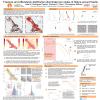Poster #161, Fault and Rupture Mechanics (FARM)
How do inertia, free surface interaction, and absolute friction coefficient level affect the final slip amplitude in a theoretical thrust fault rupture model?
Poster Image:

Poster Presentation
2020 SCEC Annual Meeting, Poster #161, SCEC Contribution #10721 VIEW PDF
an unbounded elastic whole space. This model yields the result that fault slip is proportional to the shear stress change before and after the event (often referred to as “static shear stress drop”) and to the characteristic dimension or length of the rupture/slipping region. In such a simple model, symmetry ensures that there is no normal stress change on the fault coupled to the slip process.
Nonetheless, there are many other parameters to consider other than “static shear stress drop” and “rupture length”. For example, when considering inertial effects, the final slip is typically larger (known as dynamic overshoot) than in a static model. Most importantly, the classic whole space model suggests that the absolute level of friction coefficient and the absolute level of stress does not affect the final slip amplitude; however, for a dipping fault that ruptures close to the ground surface, the non-orthogonal geometry with respect to the free surface can induce an absolute normal stress interaction that in turn can alter the shear stress on the fault through the friction formulation.
In this study, we investigate how inertia, free surface interactions, and absolute friction coefficient level affect the final slip in a thrust fault setting. We first obtain a set of analytical relations that quantitatively relate these factors to the final slip. Then, we conduct several numerical dynamic rupture models with silp-weakening friction. We demonstrate that for the same priori fault strength S and static stress drop, models will have higher fault slip and ground motion in the presence of higher friction coefficient and higher ambient stress. Our results could have important implications for ground motion on dipping faults in Southern California and beyond.
SHOW MORE
Nonetheless, there are many other parameters to consider other than “static shear stress drop” and “rupture length”. For example, when considering inertial effects, the final slip is typically larger (known as dynamic overshoot) than in a static model. Most importantly, the classic whole space model suggests that the absolute level of friction coefficient and the absolute level of stress does not affect the final slip amplitude; however, for a dipping fault that ruptures close to the ground surface, the non-orthogonal geometry with respect to the free surface can induce an absolute normal stress interaction that in turn can alter the shear stress on the fault through the friction formulation.
In this study, we investigate how inertia, free surface interactions, and absolute friction coefficient level affect the final slip in a thrust fault setting. We first obtain a set of analytical relations that quantitatively relate these factors to the final slip. Then, we conduct several numerical dynamic rupture models with silp-weakening friction. We demonstrate that for the same priori fault strength S and static stress drop, models will have higher fault slip and ground motion in the presence of higher friction coefficient and higher ambient stress. Our results could have important implications for ground motion on dipping faults in Southern California and beyond.
SHOW MORE


























































